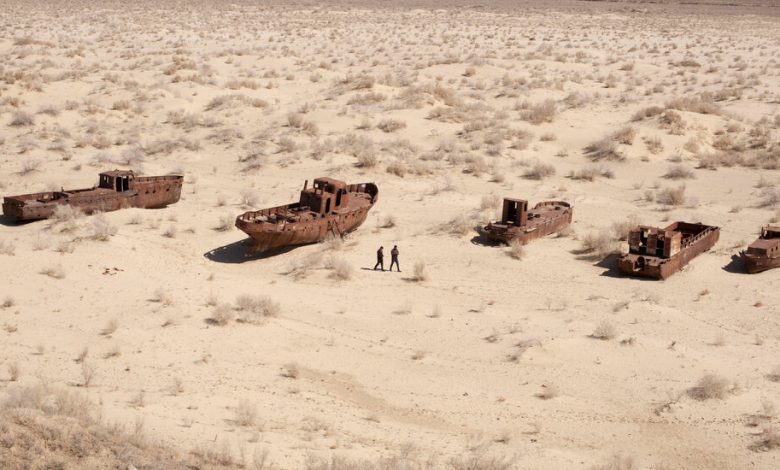Here’s How the World Looks When We Use Up All of Our Water

Walking toward the shrinking remnants of what used to be the Aral Sea in Uzbekistan was like entering hell.
All around was a desert devoid of life, aside from scrubby saxaul trees. Dust swirled in 110-degree Fahrenheit heat under a throbbing red sun. I reached the edge of one of the scattered lakes which are all that remain of this once-great body of water. I took off my shoes and waded in. The water was so full of salt that it felt viscous, not quite liquid.
In the nearby town of Muynak, black and white newsreels in the local museum, and pictures in the family photo albums of residents, tell of better times. During the Soviet era, fishing communities like Muynak ringed the sea, thriving off its bounty: sturgeon, flounder, caviar and other staples of Soviet dinner tables. In the town I met Oktyabr Dospanov, a local archaeologist who grew up along the Aral’s shores and recalls a “happy life” in his youth, when fishing boats, passenger ships and cargo trawlers plied the sea’s waves around the clock.
But over the decades, Soviet authorities diverted rivers that flowed into the sea to irrigate cotton and other crops. The world’s fourth largest inland body of water — which covered an area about 15 percent larger than Lake Michigan — gradually shrank, triggering a domino effect of ecological, economic and community collapse, the kind of catastrophe that could befall other environmentally fragile parts of the world unless we change our ways.
By 2007, the sea’s surface area had shrunk by around 90 percent, leaving Muynak a landlocked way station for tourists who come to marvel at this ecological disaster, where they take selfies near rusting ship hulks that are perched high and dry in the endless sand.
Although restoration efforts in recent years have led to small improvements in some areas, the former expanse of the Aral Sea is a blighted realm, where a scattering of far smaller, brackish lakes lie like puddles in a vast dry basin. The Aral Sea is now the Aralkum Desert. Over the decades, soil and water were contaminated by pesticides and other pollutants, which are suspected of causing birth defects and other chronic health problems in the area.
As the Aral Sea died, the region’s once-rich pastures and forests began to degrade, according to Mr. Dospanov. Birds, insects and other wildlife that depend on the sea and its wider environment disappeared. It was as if, without the sea, biodiversity went into freefall.
Salty dust blown from the parched seabed has severely impacted crops. Other livelihoods tied to the sea have also suffered, and over the decades local incomes fell and unemployment rose. The population of the region dropped as locals migrated to the Uzbek capital of Tashkent or to Moscow, where many work in construction or other low-paying jobs and often face discrimination. An entire natural and human ecosystem was destroyed. Worse, the Soviets authorities knew what was happening, but priorities like economic growth seemed more important. By the 1980s, authorities even considered compounding the folly by diverting water from Lake Baikal in Siberia, more than 2,000 miles away, to the Aral region. The Soviet Union collapsed before that scheme could be carried out.
Last year, protests broke out in Karakalpakstan, the region where the Aral Sea was located, after a proposal by the government of Uzbekistan that would have reduced the region’s autonomy. Many observers have noted that economic and environmental hardship related to the sea’s demise have added to the region’s volatility.
The really scary thing about the Aral Sea is that environmental catastrophes like it are being replicated across the world. We see refugees fleeing from uninhabitable homelands; bitter conflicts over scarce resources and land; cities threatened by rising sea levels.
In the United States, Lake Mead and the Great Salt Lake are shrinking, and cities like Los Angeles are racing to balance their water needs with a changing climate. Agriculture, fracking, lawn maintenance and other activities are rapidly depleting groundwater aquifers across America. Can we live with the possibility that other places are headed for a fate similar to the Aral Sea? The human race is using up its water and other resources like there’s no tomorrow, but as the residents of Muynak found out, there was a tomorrow, just not the one they were hoping for.
For Mr. Dospanov, the sea was a microcosm of humanity’s deep economic and social connection to the environment. A culture and a way of life blossomed around the Aral Sea, in symbiosis with it, dependent upon it. But the sea’s destruction caused everything else to collapse along with it, he said.
I left for Tashkent to catch a flight back to China where I live, eager to leave Karakalpakstan behind. But I would have to wait: Beijing had been hit by the heaviest rains in years (prompting discussion of whether climate change was partly to blame), stranding me for a while in Tashkent.
The Aral Sea stands as a grim parable, a warning of what can come from humanity’s environmental hubris. If we continue this way, waiting for somebody else to do something, or letting short-term economic interests stand in the way, we may find ourselves like Mr. Dospanov, telling visitors about how beautiful our home once was.
Jacob Dreyer is an editor and writer who lives in Shanghai.
The Times is committed to publishing a diversity of letters to the editor. We’d like to hear what you think about this or any of our articles. Here are some tips. And here’s our email: [email protected].
Follow The New York Times Opinion section on Facebook, Twitter (@NYTopinion) and Instagram.



